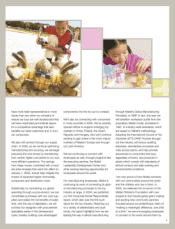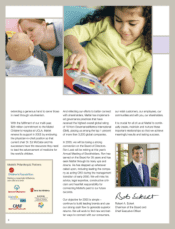Mattel 2004 Annual Report Download - page 19
Download and view the complete annual report
Please find page 19 of the 2004 Mattel annual report below. You can navigate through the pages in the report by either clicking on the pages listed below, or by using the keyword search tool below to find specific information within the annual report.Mattel customarily seeks patent, trademark or copyright protection covering its products, and it owns or has
applications pending for US and foreign patents covering many of its products. A number of these trademarks
and copyrights relate to product lines that are significant to Mattel’s business and operations. Mattel believes its
rights to these properties are adequately protected, but there can be no assurance that its rights can be
successfully asserted in the future or will not be invalidated, circumvented or challenged.
Commitments
In the normal course of business, Mattel enters into contractual arrangements for future purchases of goods
and services to ensure availability and timely delivery, and to obtain and protect Mattel’s right to create and
market certain products. Certain of these commitments routinely contain provisions for guaranteed or minimum
expenditures during the term of the contracts. Current and future commitments for guaranteed payments reflect
Mattel’s focus on expanding its product lines through alliances with businesses in other industries.
As of year end 2004, Mattel had outstanding commitments for purchases of inventory, other assets and
services totaling approximately $188 million in fiscal year 2005. Licensing and similar agreements with terms
extending through 2013 contain provisions for future guaranteed minimum payments aggregating approximately
$300 million. See Item 7 “Management’s Discussion and Analysis of Financial Condition and Results of
Operations—Commitments” and Item 8 “Financial Statements and Supplementary Data—Note 9 to the
Consolidated Financial Statements.”
Backlog
Mattel ships products in accordance with delivery schedules specified by its customers, which usually
request delivery within three months. In the toy industry, orders are subject to cancellation or change at any time
prior to shipment. In recent years, a trend toward just-in-time inventory practices in the toy industry has resulted
in fewer advance orders and therefore less backlog of orders. Mattel believes that the amount of backlog orders at
any given time may not accurately indicate future sales.
Financial Instruments
Currency exchange rate fluctuations may impact Mattel’s results of operations and cash flows. Mattel seeks
to mitigate its exposure to market risk by monitoring its currency transaction exposure for the year and partially
hedging such exposure using foreign currency forward exchange and option contracts primarily to hedge its
purchase and sale of inventory, and other intercompany transactions denominated in foreign currencies. These
contracts generally have maturity dates of up to 18 months. In addition, Mattel manages its exposure through the
selection of currencies used for international borrowings. Mattel does not trade in financial instruments for
speculative purposes.
For additional information regarding foreign currency contracts, see “International Segment” above,
Item 7A “Quantitative and Qualitative Disclosures About Market Risk” and Item 8 “Financial Statements and
Supplementary Data—Note 8 to the Consolidated Financial Statements.”
Seasonal Financing
Mattel’s financing of seasonal working capital typically grows throughout the first half of the year and
peaks in the third or fourth quarter, when inventories are at their highest levels in anticipation of expected second
half sales volume and when accounts receivable are at their highest levels due to increased sales volume,
consistent with the toy industry taken as a whole. See “Seasonality.”
Mattel maintains and periodically amends or replaces a domestic unsecured committed revolving credit
facility with a commercial bank group that is used as the primary source of financing for the seasonal working
8
























